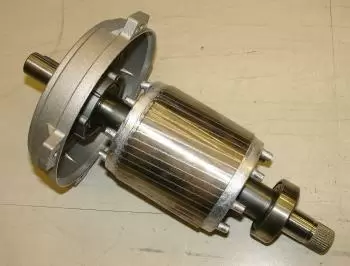
A squirrel cage rotor is the rotating part of the common squirrel cage induction motor. The squirrel cage motor is a type of AC motor.
This type of rotor consists of a cylinder of steel laminations, with aluminum or copper conductors embedded in its surface.
In operation, the non-rotating stator winding is connected to an AC power source; alternating current in the stator produces a rotating magnetic field. The rotor winding has a current induced by the stator field, and produces its own magnetic field. The interaction of the two magnetic field sources produces torque in the rotor.
By adjusting the shape of the bars on the rotor, the motor's speed torque characteristics can be changed, to minimize starting current or maximize low-speed torque, for example.
Squirrel cage induction motors are very common in industry, in sizes from less than a kilowatt to tens of megawatts.
These AC motors are simple, robust, and self-starting, maintaining a reasonably constant speed from light load to full load, set by the frequency of the power supply and the number of poles in the stator winding.
How does a squirrel cage rotor work?
An induction motor behaves like a transformer: the cage forms the secondary coil in short circuit. Under the influence of the rotating alternating magnetic field generated by the stator coils, induction currents will start running in the secondary windings. Due to the Lorentz force that is integrated between the magnetic field and the current-carrying cage, the rotor will start to rotate.
However, the rotational speed of the rotor will be slightly less than the rotational speed of the rotating magnetic field generated by the stator coils. If the rotor were to work synchronously with the stator field, there would be no flux difference and no power generation and therefore no force. That is why machines with a cage rotor are called asynchronous machines or induction machines.
A characteristic of the squirrel-cage rotor is the low starting or starting torque in combination with the relatively large starting current (approximately 5 to 7 times the rated current). Over time, therefore, various alternative constructions have been devised to improve the approach behavior of the cage anchor.
Rotor resistance
By producing the rotor cage from a material with a higher specific resistance (eg brass instead of copper), the resistance of the rotor will increase. As a result of this increase, the starting torque of the electric motor will increase and the starting currents will decrease.
The disadvantage is that during normal operation the copper losses in the motor are much higher than in the normal crate motor (low efficiency). This type of rotor is mainly used for motors that are not continuously in operation but require high starting torque.